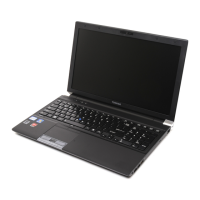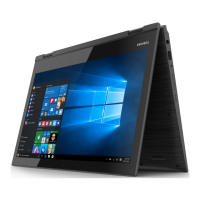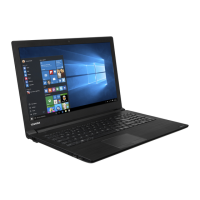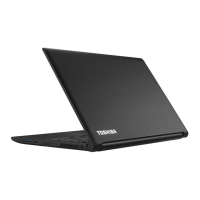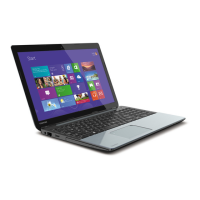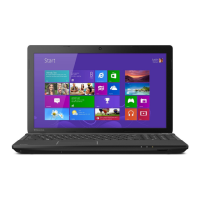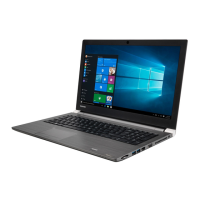
Do you have a question about the Toshiba SATELLITE R850 and is the answer not in the manual?
Instructions for ensuring proper airflow to prevent overheating.
Guidelines for setting up an optimal workspace for the computer.
List of included hardware, documentation, and pre-installed software.
Explains the function and status of various system indicators on the computer.
Identifies ports and features on the left side of the R850 model.
Details on external RGB monitor, HDMI, DisplayPort, and USB ports.
Identifies ports and features on the right side of the R850 model.
Identifies components on the back and underside of the R850 model, including battery features.
Identifies components visible when the display is open on the R850 model.
Explains dedicated buttons like eco, presentation, power, and pointing devices.
Overview of the Touch Pad and AccuPoint pointing devices.
Details on keyboard functions, FN key combinations, and AccuPoint usage.
Guide to enrolling and using the fingerprint sensor for authentication.
Procedure for setting up fingerprint authentication for the first time.
Instructions for deleting fingerprint data from the computer.
How to log in to Windows using TOSHIBA Face Recognition with different modes.
How to set and manage user passwords for computer access.
Setting supervisor passwords and starting the computer securely.
Program for configuring computer hardware settings and BIOS.
Information on the computer's optical disc drive, supported formats, and usage.
Information on writable discs and software for writing data to discs.
Information and limitations of the disc creation software.
Guide to creating DVD-Video or Blu-ray Disc™ movies using Corel Digital Studio.
Information and limitations of the video playback software.
Guide to using the WinDVD BD software for Blu-ray playback.
Overview of wireless communication functions and devices.
Steps to configure wireless settings and enable encryption for security.
Information about Bluetooth wireless technology, its features, and operation.
Information on the computer's built-in Ethernet LAN support and connection methods.
Information on optional devices that can expand computer capabilities.
Information on using Smart Cards and the Smart Card slot, including insertion.
Information about the memory media slot and supported card types.
Safety precautions for handling memory media cards and their specifications.
Precautions for handling memory cards to prevent damage.
Procedures for inserting and removing memory media from the slot.
Instructions for installing and removing memory modules to increase system memory.
Detailed steps for installing a new memory module.
Detailed steps for removing a memory module from the computer.
How to connect an external monitor to the computer and its cable.
Procedure for connecting an HDMI device to the computer's HDMI out port.
Information on connecting external SATA devices to the computer.
How to use a security lock to prevent theft of the computer.
List of optional accessories for enhancing computer functionality.
Instructions on how to clean the computer safely without causing damage.
Description of pre-installed utilities and how to start them.
Feature allowing charging of USB devices when computer is off or in low power states.
Login mode where face authentication is selected by default.
Login mode requiring account selection before face authentication.
Selects the display used when the computer starts.
Step-by-step guide to creating recovery media for system restoration.
How power conditions affect computer capability and battery status.
Explains the meaning of different battery indicator lights for status.
Guidelines for effectively identifying and resolving issues through observation and documentation.
Basic checks to perform when troubleshooting computer problems, focusing on simple solutions.
Steps to close unresponsive programs using Task Manager.
Troubleshooting steps if the computer fails to power on or boot.
Troubleshooting steps for computer shutdown due to overheating.
Information on how to contact TOSHIBA for additional technical assistance.
Physical dimensions of the computer models R850, R840, and R830.
Operating and non-operating environmental conditions for the computer.
Electrical power specifications for the AC adapter and computer.
Footnotes regarding CPU performance variations under different conditions.
Information on Wireless LAN compatibility and standards.
Information on Bluetooth compatibility and standards.
